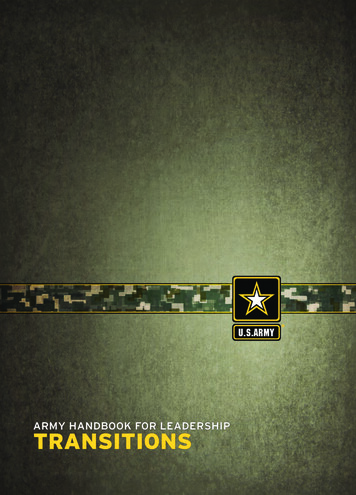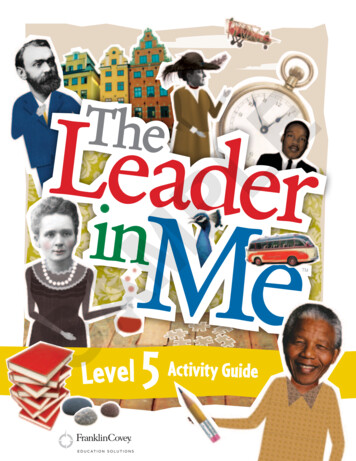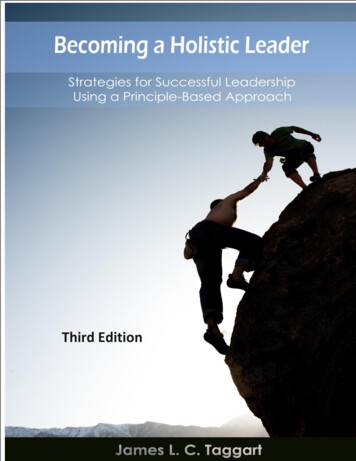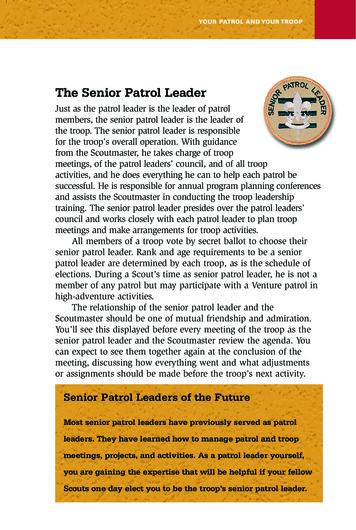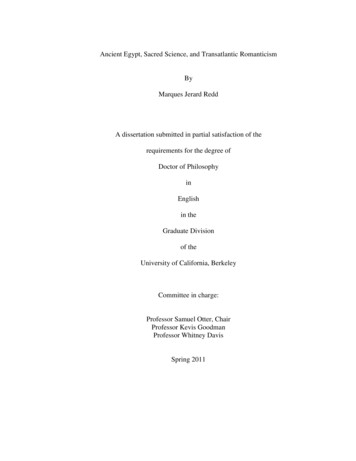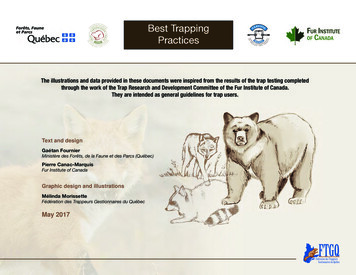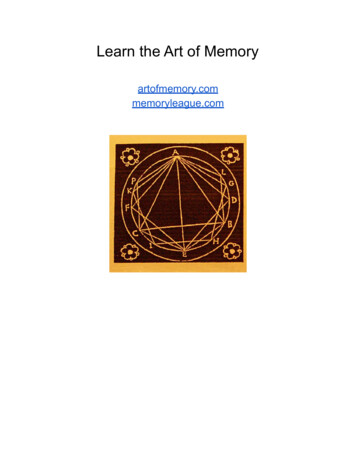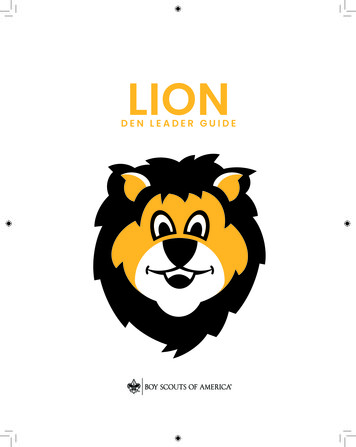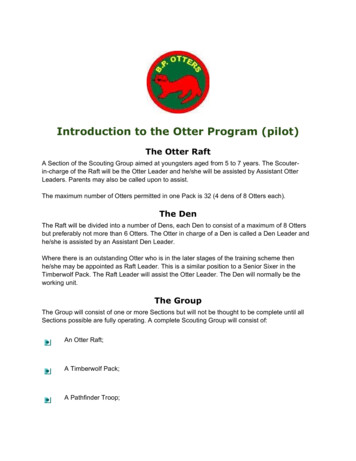
Transcription
Introduction to the Otter Program (pilot)The Otter RaftA Section of the Scouting Group aimed at youngsters aged from 5 to 7 years. The Scouterin-charge of the Raft will be the Otter Leader and he/she will be assisted by Assistant OtterLeaders. Parents may also be called upon to assist.The maximum number of Otters permitted in one Pack is 32 (4 dens of 8 Otters each).The DenThe Raft will be divided into a number of Dens, each Den to consist of a maximum of 8 Ottersbut preferably not more than 6 Otters. The Otter in charge of a Den is called a Den Leader andhe/she is assisted by an Assistant Den Leader.Where there is an outstanding Otter who is in the later stages of the training scheme thenhe/she may be appointed as Raft Leader. This is a similar position to a Senior Sixer in theTimberwolf Pack. The Raft Leader will assist the Otter Leader. The Den will normally be theworking unit.The GroupThe Group will consist of one or more Sections but will not be thought to be complete until allSections possible are fully operating. A complete Scouting Group will consist of:An Otter Raft;A Timberwolf Pack;A Pathfinder Troop;
A Rover Crew.The Scouting Group will be in the charge of a Group Scouter and each Section of the Group willhave a Section Leader with Assistants.The Group CouncilThis will consist of all the registered Scouters in the Group and this Council will, under theguidance of the Group Scouter, deal with all matters affecting the training of the Group.The Group Council is responsible for determining what requirements are necessary to carry outits' duties, and the views of the Group Council are put to the Group Committee by the GroupScouter.The Group CommitteeThe Group Committee consists of a Chairman, Treasurer, Secretary, representatives of theSponsoring Authority and parents, supporters and friends of the Group.The main function of this Committee is to support the Group Scouter to efficiently run the Group.The main task is the raising of finance for equipment and normal running costs of the Group.Uniformed, Warranted Leaders do not take on the roles of Officials of the Group Committee.They may, subject to the Group's own desires, sit on the Group Committee but should not takean active part and should be acting in an advisory capacity.To put a halt to any hint of a conflict of interest, Parents who are also Scouters in the Groupmay not sit on the Group Committee in any capacity.Raft ParentsThese are either Instructors (of any sort) or assisting parents who are allocated to supervise aparticular Den and in some cases to actively participate in and encourage the Den to do its' bestin activities of whatever description.This is not to take away from the Den Leader any responsibility but to act as a normal parentwould to his/her family, which is what the Den is meant to be. It should be the aim of the OtterLeader to have a Den Parent for each Den, as adequate supervision is at all times a necessity.NOTE: It is essential that a background check be done by ANY parent who volunteers to workwith the Raft.
Raft Scouters NamesAll registered Otter Raft Sections are required to use the name "AHMEEK" for the Otter Leader.Names for Assistant Leaders and for other instructors (of any sort) and Adult helpers will be leftto the discretion of the Section concerned.Names for Assistant Otter Leaders may be taken from:Atsak: The Black Bear Nanuk - The Polar BearQimmik: The Husky Dog Nauyat - The SeagullAiviq: The Walrus Tuktu - CaribouAmaruq: The Wolf Ukpiq - The OwlIguttaq: The Bumblebee Tiriganiaq - The Artic FoxQilalugaq: The Beluga Whale Oomingmak - The MuskoxBadges of RankOtter Leaders and Assistant Leaders wear their association’s uniform as provided in theassociation’s PO&R (typically the Rover uniform).The Raft Leader will wear three half-inch wide white tape rings around the left arm between theshoulder and elbow.The Den Leader will wear two half-inch wide white tape rings around the left arm between theshoulder and elbow.The Assistant Den Leader will wear a single half-inch wide white tape ring around the left armbetween shoulder and elbow.
Otter InstructorsOtter instructors may be Pathfinders of at least Second Class standard and meet the approvalof the Pathfinder Troop Leader; and approval must first be obtained before the appointment ismade. A suggested probationary period of 1 month is recommended to allow the instructor to beassessed.Rover InstructorsA Rover wishing to take the Rover Instructor Badge with the Otter Section and with the approvalof the Rover Skipper, must hold the Service Training Star and act as an instructor to thesatisfaction of the Otter Leader and Group Scouter.Otter Badges & Award SchemeThis scheme is designed to develop and stimulate the Otter and give a variety and Interest tothe Program. It is progressive throughout the period between 5 years and 8 years of age andshould be spread over the full three years.The scheme consists of an Investiture Badge, Four Progress (Paws) Badges, a link to theTimberwolf Pack with the Swimming Otter Badge, Two Camping Badges, a Safety Badge and aService Badge.Each Otter Den should wear a 4 cm square felt patch of their Den color at the top of their rightarm. Acceptable colors are: Red, Purple, White, Green, Blue, and Orange.Investiture Badge1. Know a little about Otters.2. Know the Otter Motto (Busy and Bright).3. Know the Otter Salute and Sign.4. Know a little about B-P, the Founder of Scouting.5. Take part in an Opening and Closing Ceremony.6. Know the Otter Law.Signoff
7. Know the Otter Promise.Otter Law“An Otter is always busy and bright and helps other people by doing a good turn every day.”Otter Promise“I promise to do my best, to obey my Leaders and my parents and to be a good Otter.”Otter Salute & SignThe Otter salute and sign are similar to those of the Timberwolf section, with the exception thatthe fingers are held together and not apart. Make the sign by holdin up the 1st (pointer) and2nd fingers on the “right” hand, elbow to your side and sign pointed upwards.The salute is the same as the sign, but with the hand brought to the corner of the right eye-brow(or right corner of the hat) in a salute position - elbow straight out.Safety Badge1. Know your name and address.2. Know your phone number.3. Be able to print your name.4. Know how to cross the road safely.5. Know about safety with strangers.6. Know the basic rules of health and hygiene.7. Know about safety around the home.8. Be able to tie your own shoe laces.9. Know what 911 is for and how to call it.10. Know how to put a Band-Aid on a cut.11. Know your Mom and Dad's full names.Signoff
Helping Badge (Red Paw)Signoff1. Know about helping others and sharing with others.2. Know about cleanliness and caring for your clothes.3. Be helpful around the house.4. Do a good turn for a relative or a neighbor.5. Take part in a Kim's Game.6. Take part in the Message Game.7. Know how to wash dishes and clean up a table.8. Take part in a Raft good turn.9. Visit an Old Folk's Home and help serve tea and cookies.10. Help set up your meeting hall.Activity Badge (Blue Paw)1. Be able to throw and catch a ball.2. Take part in a night hike.3. Take part in two day hikes.4. Be able to sing 3 songs.5. Have an awareness of children with disabilities.6. Know how to Skip Rope.7. Take part in team and solo games or sports.Signoff
8. Know how to be a good loser and a good winner.Handicraft Badge (Tan Paw)Signoff1. Draw, and color, a scene or event from a story.2. Draw a picture of your house.3. Make a Thank You card.4. Make a model.5. Make a collage.6. Collect 25 stamps (or other similar item) and mount them in a book ordisplay.7. Make two craft items.8. Tie a Square (reef) knot.9. Make a bird feeder from a milk jug.10. Visit a petting zoo.Square (or "Reef") KnotSquare Knot. Used for joining ropes of equal thickness. It is also the knot used for tying bandages,as it lies flat. This knot is also known as a "Reef Knot". The working end is tied over the standingend, "right over left, left over right."
SignoffNature Badge (Green Paw)1. Know about caring for the outdoors.2. Name 6 animals that are kept as pets.3. Make a scrap book about Otters.4. Collect 10 flowers and 10 leaves and press them.5. Grow a seed in a water soaked paper towel.6. Grow a carrot top in water.7. Take part in a Raft Nature Walk.8. Take part in a trail clean-up.9. Plant, and take care of a tree for at least a yearSwimming Otter BadgeThis badge is presented to the Otter at his Timber Wolf investiture by hisOtter Leader, and may be worn until they have earned their second star.1. Know the story of Mowgli.2. Know the Timber Wolf Motto.3. Know the Timber Wolf Salute.4. Know 2 knots - Clove Hitch and Figure 8 Knot.5. Have the Safety Badge.6. Have earned all 4 Paws.7. Visit the Timberwolf Pack 3 times.Signoff
SignoffCamping BadgeAwarded to Otters who have spent 5 or more nights camping.The Service BadgeSignoffThe Service badge is awarded to an Otter who has completed all of thefollowing Activities, which must be carried out over a period of at least 8months.1. Visit the local Police Station and find out some ways to help prevent crime2. Visit the local Fire department and find out the danger of fire and someways of preventing it3. Find out about preventing accidents a. in the homeb. on the roadc. in the playgroundd. in the swimming pool4. Find out about recycling of waste, what use can be made of recycleditems and take part in a recycling operation.5. Find out the effects of vandalism on an area and how the cost of repaireffects your family.6. Visit the local Ambulance Station and learn about what they do.Uniform1. Adults wear the uniform as described in your Association PO&R (Policy, Organizationand Rules). and do not wear the uniform of the youth members.2. Youth members wear a long sleeve red t-shirt or sweatshirt and a plain red cap (cap isoptional). These items are available in most clothing stores for minimum cost. Badgesare sewn directly onto the shirt.
BadgesBadges are worn in the following places on the youth uniform (Adult badge positions are shownin the PO&R).1.2.3.4.5.6.7.WFIS Badge: Worn on the right breast.Investiture Badge: Worn on the left breast.Safety Badge: Worn on the left sleeve.Paw Badges: Worn on the right sleeve.Service Badge: Worn at the top of the right sleeve below Group Title Flash.Group Title Flash: Worn at the top of the right sleeve along the seam.Swimming Otter Badge: Is not worn on the Otter uniform. It is presented at theirTimber Wolf Investiture by Ahmeek (The Otter Raft Leader), and is worn only on theTimberwolf uniform.The Otter SignThis is carried out with the right hand. The thumb holds down the last two fingers across thepalm and the other two fingers are held straight up.The right hand is then used in the same way as the Military salute, i.e. touching the cap.The Otter SaluteThe fingers are held in the same position as the salute but the hand is held straight up with theelbow touching the side of the body. This position is adopted when making or renewing thePromise.A Suggested Opening CeremonyThis should be preferably be taken by Ahmeek and should be the first event of any Raftmeeting.The first command by Ahmeek will be the shout "Council Rock". At this command the Otters willform a circle, Otters are facing inward and holding hands.An Assistant Leader will raise the National Flag and all will salute.The Pack then sing (to the tune "The Old Grey Mare"):Here we sit like Otters on a Cedar log,Otters on a Cedar log,Otters on a Cedar log,Here we sit like Otters on a Cedar log,Waiting for the fun to start,Waiting for the fun to start,
Waiting for the fun to start,Here we sit like Otters on a Cedar log waiting forThe fun to start. YEAH!!!!The Raft then breaks off to their corners for uniform and paw inspection and the collection ofdues.This is a simple, but effective opening, which will not task the children too much. It isrecommended that ALL Otters, invested or not, take part in the opening and closingceremonies.The Closing CeremonyThis should be preferably be taken by Ahmeek and should be the last event of any Raftmeeting.The first command by Ahmeek will be the shout "Council Rock". At this command the Otters willform a circle, Otters are facing inward and holding hands.The Raft sings 'Taps":Day is done, (stand motionless)Gone the sun, (point Skyward)From the lake, (Extend both arms towards floor)From the hills, (move both arms, parallel to floor)From the sky, (move both arms towards sky)All is well, safely rest, (lower arms slowly)God is near. (bow head)The Raft then says the Closing Thoughts:Thank you, friends, for this dayFor my family, and for my play.Thank you for the good things to eat,For eyes and ears, and hands and feet.Thank you friends for all you doAnd, I will try to help you, too.An Assistant Leader then lowers the National Flag.Ahmeek will now make any Raft announcements.The Raft will then sing the Scout Vesper Song (to the tune "Oh Christmas Tree"):Softly falls the light of dayAs our meeting fades away;
Silently each Otter asksHave I done my daily task?Have I kept my honor bright?Can I guiltless rest tonight?Have I done and have I daredEverything to 'Be Prepared'.The Raft is then dismissed.The Investiture of an OtterAt the first Raft meeting a new Otter is placed in a Den, preferably with someone who is afriend. The new Otter may wear the Otter uniform with the exception of badges and neckerchief.In order to be invested an Otter must pass the tests as outlined in the Otter Badges and AwardScheme. Ahmeek will take the investiture and this should be done at the beginning of a Raftmeeting. When the Raft is in the 'Council Rock' formation, Ahmeek will ask the Den Leader ofthe Den concerned to bring forward the new recruit to be invested. The Otter then makes theOtter Sign and repeats the Otter Promise.First having given the Otter Law. The newly invested Otter is then presented with theMembership Badge and group neckerchief and is welcomed into the Worldwide Brotherhood ofScouting with the Scout Handshake. The new Otter turns and salutes the Pack and all investedOtters return the Salute.Swimming up to TimberwolvesThis is the ultimate ceremony in the Otter Raft for the Otter, as it marks the departure for newpastures in the Timberwolf Pack. This is a joint affair between Ahmeek and Akela who mustwork together to make it a success.Before finally moving up to the Timberwolf Pack, the Otter will have visited the Timberwolf Packon several occasions to meet the Old Wolves and their prospective Sixer.The Otters are in 'Council Rock' formation and the Timberwolves are in 'Pack Circle' Formation.The open ends of both formations will face each other.The Otter to 'Swim Up' will face Ahmeek in the centre of the 'V' of the Council Rock formationand the Otters will do their opening ceremony. The Timber Wolves will then do their openingceremony. The Otter concerned will then go around the Raft and shake hands for the last timeas an Otter. Ahmeek will then take the Otter forward to meet Akela. The new Cub will then beformally presented to his new Sixer and the members of his new Six.The Otters and Timberwolves will then take part in a joint game, and refreshments before theOtters leave for home.
About OttersThe ancestors of otters probably lived on land. Over millions of years, they adapted to life inthe water. The two main kinds of otters are river otters and sea otters. They are found on everycontinent except Australia and Antarctica.The American river otter is found throughout most of North and South America. Sea Otters livealong the Pacific coast of North America, the Aleutian Islands off Alaska, and northeastern Asia.Otters are mammals. They are covered with fur and nurse their young with milk. They Breatheoxygen from the air. Otters are related to Skunks, mink, weasels, martens, and badgers.Otters belong to the weasel family - Mustelidae. The scientific name for the American river otteris Lutra Canadensis. The sea otter is Enhydra Lutris.River OttersRiver otters live near rivers and lakes. They spend much of their time swimming. Otters feed onfish and small animals such as crayfish. They can crush shells and slice fish with their strongsharp teeth. They also eat snakes, clams, snails, frogs, and even earthworms.River otters have a small, flattened head, long whiskers, and a thick neck. They have apowerful, tapered tail that makes up one-third of their length.Adult male river otters weigh 4.5 to 14 Kilograms. They measure up to 1.4 meters long,including the tail. Females are somewhat smaller. Otters can hold their breath and stay underwater for up to four minutes.River otters have good eyesight and a very keen sense of smell. They make many differentsounds. They chatter, chuckle, grunt, snort, and growl. They also warn other otters of dangerwith a shrill whistle.Legs, Feet, and EarsOtters have short legs with five toes on each foot. Elastic skin called webbing between the toeshelps them swim. Except for pads on their toes and soles, their feet are covered with fur. Theyuse their paws to feel for crayfish under rocks in muddy riverbeds. They hold food in their frontpaws while they eat it. Special muscles allow otters to close their small ears and nostrils to keepwater out.Otter FurThe fur on the river otter's sides and back is a rich black-brown color. The fur on the belly islighter, and the chin and throat are grayish. Coarse guard hairs cover their thick, soft under-fur.River otters take good care of their beautiful fur. They groom their coats every day. They roll onthe ground to dry their fur and keep it waterproof. Their fur protects them from the cold.River Otter TerritoriesRiver otters mark their territory by rubbing musk on logs and stones. Musk is a sweet smellingliquid produced by scent glands near the tail. Otters have dens, or homes, on land, in the banksof rivers and ponds. Sometimes they take over an abandoned muskrat or beaver den dug into ariverbank.
Otters are nocturnal animals. They are active at night and usually sleep in the daytime.When they are not hunting for food or grooming their beautiful fur, otters love to run around.They wrestle and chase each other. Otters like to slide down a slippery slope into a pond orstream. Then they race up the slope so that they can slide down again.River Otter PupsOtters must be at least two years old to mate. The mating season usually comes at the end ofwinter. Two months later up to four pups, or cubs, are born. The pups' eyes are closed for fiveweeks. They have no teeth. They feed on their mothers milk. The mother otter takes care oftheir pups for almost a year. When she takes out of the den, the father may join his family. Theparents teach their pups to swim, dive, catch food, groom their fur, and slide down slopes.EnemiesFor hundreds of years, river otters were killed for their thick, beautiful fur. It was used to makecoats, hats, and other articles of clothing. Today many governments have laws against otterhunting. But humans are still one of the worst enemies. Many of these wonderful animals arekilled by cars when they cross roads at night.
Otter Raft Leader(s)The leader in the Raft must at all times try to beyond reproach. The Otters will look up to you toshow the way and will mimic what you do.Simple speech, clearly expressed, should be the order of the day. Listen to the things thatchildren say, not only to you but amongst themselves. Encourage them to discuss things andnot just to accept things blindly. We should be prepared to tell them why a certain thing has tobe done so that they may more fully understand and learn.As your mood will be reflected in them, a relaxed, friendly atmosphere with lots of activity forhealthy exercise, coupled with love and sympathy and understanding should be aimed for.Handicraft sessions provide a creative outlet and some Otters will be more at home with sometypes of handicraft than others. Try to provide the special type for the youngster rather than justprovide a general 'all of you will do this tonight' type of session.Obviously you will have to find out what special handicraft suits the child so the full range willhave to be tested first.Story time is an essential part of the Raft Meetings as it provides an opportunity for relaxationbetween boisterous periods.Leader ResponsibilityThe person chosen to lead an Otter Raft, must of course, be a person of good character, as withall Scouters. As they are in the limelight and open to criticism they should be above reproachand be seen to be living up to the image that Scouting projects world-wide. This also applies tothose assisting in the Raft in whatever position.The Association will be judged by the worst one of us, unfortunately, and we must endeavor atall times to do our best. When in public, always consider that you are being watched, becauseyou are!A friendly disposition is necessary and this rubs off on the youngsters in the Raft. We must beable to be "one of the gang" and at the same time make the youngsters understand that we, asScouters, although brothers and sisters in Scouting, are there to know better than they do andtherefore to be obeyed.As relationships build up between Scouters and the Otters it will become apparent that theOtters place a lot of faith in 'Ahmeek' or whoever and this faith should never be shattered. Alltheir problems will end at the Scouters feet and, although to us they will be at times trifling, tothe Otters they will be problems of great magnitude. We must ensure that we are absolutely fairin resolving their little problems and youngsters who seem to stand out as 'Loners" should beput at ease and integrated into a 'team', which is what a Den should be.
Scouters will find that, as time goes by, they will gain experience and will be able to use thatexperience in efficiently administering the Raft. Intimate knowledge of a youngster's homeenvironment, likes and dislikes, physical infirmity and standard of education is necessary, toenable a fuller understanding of that youngsters attitudes and to enable him/her to take a moreactive part in Raft activities.A good relationship with the parents is a must as we need the co-operation of the parents andtheir support in our activities. With the Otter Section a lot more interest is shown by parents andwhen the youngsters are brought to meetings or activities the parents should be able to seethat we care about their children and at this stage contact can be made, sometimes to goodadvantage, by getting the parents involved.As time passes we find that more and more children are from broken homes or single parentfamilies. No stigma should be attached to an Otter as he/she is not to blame for what has gonebefore. All Otters should be treated as to their individual requirements without fear or favor,for once the youngster thinks that someone else is being favored their respect for the Scouterconcerned is lost. Contact with your local Pastor or Minister will probably result in informationbeing available to assist in understanding a particular child and can only be an advantage.Not all parents are interested in the activities of their children and an effort should be made toform a friendly relationship with all parents and to promote an interest in those parents who arenot keen.Ahmeek must make full use of all assistance available to him/her as not to do so will resultin the offer of that assistance sometimes being withdrawn. There is nothing worse for a keenperson than to be left standing like an ornament during activities. All Otter Section Scouters andinstructors are a team and all their various skills should be fully utilized. Use may also be madeof Scouters from other Sections of the Group. This not only makes available a fuller range ofskills but shows to the Otter that he/she is part of a bigger family than just the Raft.Where Raft Scouters have a problem remember the old adage "A problem shared is aproblem halved" and the Group Scouter should be in a position to give good advice. Weare not perfect in ourselves but between us we should be in a position to resolve mostproblems. Remember another old adage that says "Nothing is a problem until you make one!Leader TrainingAs with training for other Sections this consists of a Part One Training Course which will last forone weekend or several evening sessions. At the end of the course a certificate will be issuedand a two-strand Turk's Head Woggle will be presented.Following this 12 months later will be Part Two Training, which will consist of several weekends,normally a month apart, in which the practical skills of Scouting will be presented.Part Three will consist of a probationary period of 6 months, after which a report will besubmitted by the Group Scouter, on the suitability of the candidate in putting into practice whathas been learned during the Wood Beads Badge Training.
When a recommendation as to suitability has been received by the trainers, a further certificatewill be issued, together with the Wood Beads Badge proper and the Wood Beads Neckerchief.Whilst the above is not at this time compulsory, it is hoped that all Scouters will want to becomeas proficient as possible and will take that training. We can all benefit from an exchange ofideas, which is inevitably a product of such training.
Atsak: The Black Bear Nanuk - The Polar Bear Qimmik: The Husky Dog Nauyat - The Seagull Aiviq: The Walrus Tuktu - Caribou Amaruq: The Wolf Ukpiq - The Owl Iguttaq: The Bumblebee Tiriganiaq - Th


